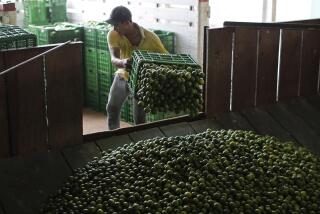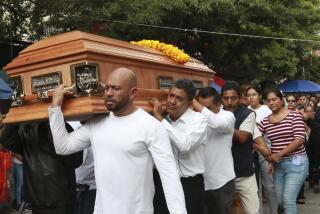Thousands Take Part-Time Role : ‘Weekend Warriors’ Aid Salvador Rebels’ Strategy
- Share via
SAN SALVADOR — Jose Cabanas does odd jobs during the day, driving a vegetable delivery truck, repairing streets and trimming bushes. At night, he blows up utility poles.
Cabanas--it’s not his real name--is one of thousands of what are called guerrilleros milicianos, a kind of weekend warrior for the Farabundo Marti National Liberation Front (FMLN), the leftist rebel organization that has been waging a war against the government here for nearly eight years.
For the record:
12:00 a.m. Nov. 4, 1988 For the Record
Los Angeles Times Friday November 4, 1988 Home Edition Part 1 Page 2 Column 6 Foreign Desk 2 inches; 44 words Type of Material: Correction
An article published Wednesday about rebel militiamen in El Salvador’s civil conflict understated the amount of U.S. aid given that country. In fiscal year 1988, El Salvador received a total of $541.9 million in direct economic and military aid, military education and training, and credits and loan guarantees.
Numbering up to 40,000 and working with an estimated 6,000 full-time guerrillas, this militia force has become a key part of an evident shift in guerrilla tactics toward sabotage, hit-and-run attacks on small military garrisons and terrorism, both in the countryside and, increasingly, in the cities.
Some diplomats and ranking Salvadoran military officials say the militia presents the greatest danger to the government because of the near impossibility of defending against its actions without using the repressive, even brutal tactics that could ignite popular resentment and destroy the already tenuous support that the United States and other nations express for this government.
“They are fighters,” Col. Juan Carlos Orlando Zepeda, commander of the army’s 1st Brigade and former chief of intelligence, said of the militiamen. “But their main role is to carry messages, gather intelligence, carry out propaganda and sabotage, provide logistical support, stage hit-and-run attacks.
“They are a crucial factor in carrying out the FMLN strategy for a popular insurrection,” Zepeda said in an interview. He added that the militia also serves as an important link between the rebel fighters and the masas , the civilians who sympathize with the guerrillas but do not actively join them.
The Salvadoran high command, U.S. diplomats and military analysts theorize that the guerrillas have dropped plans for defeating the government through direct military action. Instead, they have opted for a strategy aimed at sparking a popular uprising.
This strategy includes terrorist acts. In one week last month, guerrillas set off car bombs in San Salvador and then guerrillas in civilian clothes boarded a bus in the capital, killing a passenger and three soldiers guarding the vehicle.
In the countryside, the rebel strategy encompasses murdering elected mayors and forcing civilians suspected of being government sympathizers to leave their homes. For example, the mayor of Sociedad, a town in the northern province of Morazan, was killed last month, and the army charged that 26 families in the province of Chalatenango were driven from the village of San Fernando by the guerrillas.
The motive for such actions, the theory holds, is to provoke the army into such a bloody reaction that the government will lose crucial U.S. military and economic aid--now totaling about $90 million a year--and the Salvadoran people will join a general insurrection.
Emphasis on Terrorism
Because the guerrilla army is spread thinly about the country, many of the attacks, particularly those in San Salvador, are carried out by the so-called militia. They are blamed especially for the terrorism.
“The militia is trained to kill in cold blood,” said Col. Mauricio Ernesto Vargas, chief of army operations. “Many are ideologues, most are young. They come from the universities and are motivated by adventure, frustration and ideology. Many are protected by the (Roman Catholic) church.”
That profile is only partly true, according to the 27-year-old Cabanas, whose schooling stopped at the fourth grade. He calls himself a typical militia member and says he developed sympathy for the guerrillas first because they promised to change the desperate economic situation of his family and then because of the military’s oppressive counter-tactics.
‘I Can Do Other Things’
“I couldn’t leave and fight (with the guerrilla forces in the countryside) because there is no one else to support my family,” he said. “But I can do other things.”
Cabanas, who asked that his real name not be used in order to protect himself from the army, lives in a town on the outskirts of San Salvador near the San Salvador volcano, which is a stronghold of guerrilla and militia forces.
He said he receives his militia assignments on an irregular basis from contacts who operate from the volcano area.
“There are a lot of us,” Cabanas said in an interview in the shanty that he shares with his aunt and several younger brothers and sisters. “Some of us set explosives,” he said, while others do exactly what Zepeda described: run messages, obtain supplies and join the regular guerrilla forces when needed.
“An important task is to watch and report what the military is doing,” he said. “We watch the army and send alerts to the comandantes so they can set up ambushes.”
‘Depopulated’ Areas
Although there are large militia groups, as well as regular guerrilla units, in the San Salvador area, a major part of the rebel strength is in the countryside, especially in the so-called “repopulated areas” along the border with Honduras.
Because the government sees these regions as important centers of rebel support by the civilian population, the Salvadoran military, using U.S.-provided planes, helicopters and artillery, “depopulated” the areas.
However, under an amnesty declared by the government and in accordance with provisions of a Central American peace plan, many of the refugees from the depopulated areas have been returning from camps in Honduras. Zepeda of the 1st Brigade and Vargas, the operations chief, say that among them are thousands of former guerrilla fighters and other sympathizers who make up the militias.
This assessment is shared by diplomats. One official of a European embassy here said in an interview that the “growth of the militias is in the repopulation zones and includes the amnestied people. Many are ex-guerrillas. There are even some in the army--infiltrators.”
Without saying so directly, the army tacitly acknowledges that infiltration is a problem. “We don’t recruit here,” said Lt. Col. Roman Alfonso Barrera, commander of the San Franciso Gotera garrison in Morazan. “We only take people from the east.”
Movement of Refugees
Another problem for the army in fighting the new rebel strategy has been the movement of refugees within the country. The army presumes that large numbers of rebels and militia move with the uninvolved civilians.
Army officers say, for instance, that thousands of refugees have moved from Chalatenango and Morazan provinces westward and southward into San Vicente, San Salvador and Santa Ana provinces. Those areas recently have all seen serious increases in anti-government violence. Yet, the militia strength is such that part-time forces have been able to fill the gap in Morazan left by the shift of guerrilla regulars to areas near the capital and south of it, the army says.
“Clearly, this type of war has a negative impact on us, “ Zepeda said. “They present incremental efforts to ignite the masas to uprisings, to cause social disorder. The guerrillas can’t mount an offensive, but they can set off an uprising.”
The army sees itself as hamstrung in handling the militia.
Wants ‘Total War’
“Fighting the organizing efforts and the terrorism is the hardest,” said Zepeda, who is described by diplomats as wanting to fight “a total war” against the guerrillas.
“What we need is a state of emergency,” he said, one that would allow the army to arrest suspects without having to take them before civilian judges quickly, as current law requires. It would also allow house searches without warrants and permit the army to try suspects before military courts.
This sort of thinking alarms human rights groups and even some U.S. officials, who otherwise argue that the military is conducting a relatively clean war against the guerrillas.
There have been some scattered signs that the military is dropping its previous self-restraint. In September, army troops killed 10 peasants suspected of helping the guerrillas in San Vicente province. Under pressure from the U.S. Embassy, the government acknowledged that the army had been involved and ordered the arrest of several soldiers.
More recently, the FMLN and some human rights groups charged the military with invading a repopulated village in Chalatenango and then using heavy machine guns fitted to a C-47 cargo plane to destroy the town.
Thoughtful Leader
Vargas, who is regarded by the U.S. Embassy and other diplomats as one of the best and most thoughtful leaders in the army, also wants more freedom to fight the militia threat.
But he says that creation of a state of emergency “is a political decision” and will not be unilaterally imposed by the army.
“This is not a war that has a military solution,” he said. “With the militia living in their midst, the people won’t fully accept us.
“The real problem is a lack of work, the poor economic situation and the breakdown of the political system. That is our most serious threat.
“We have to attack that.”
More to Read
Sign up for Essential California
The most important California stories and recommendations in your inbox every morning.
You may occasionally receive promotional content from the Los Angeles Times.










